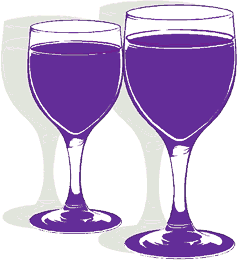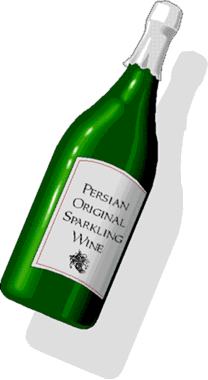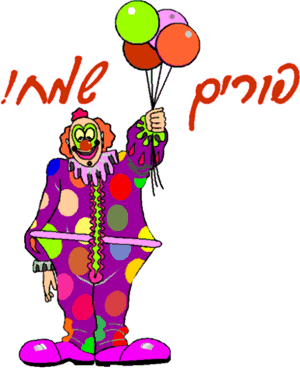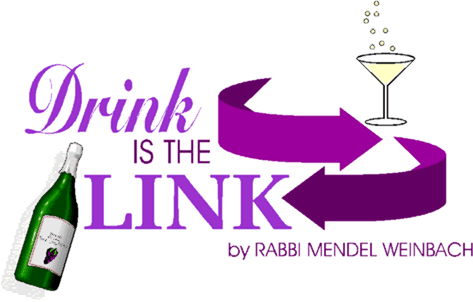Drink is the Link
This publication is also available in the following formats: ![]()
![]()
![]() Explanation
of these symbols
Explanation
of these symbols
A man is obligated to imbibe on Purim until he can no longer distinguish between "Cursed is Haman" and "Blessed is Mordechai."
 urim is a veritable
cornucopia of paradoxes which ignite the imagination of both scholar and layman. But
perhaps the greatest challenge of all is posed by this requirement to indulge in drink to
the point of losing the faculty of discernment. How, ask the commentaries throughout the
generations, can we be commanded to invite that very intoxication which is so roundly
reviled in both Scripture and Talmud? And why such a puzzling standard of non-discernment?
urim is a veritable
cornucopia of paradoxes which ignite the imagination of both scholar and layman. But
perhaps the greatest challenge of all is posed by this requirement to indulge in drink to
the point of losing the faculty of discernment. How, ask the commentaries throughout the
generations, can we be commanded to invite that very intoxication which is so roundly
reviled in both Scripture and Talmud? And why such a puzzling standard of non-discernment?
 Just to set the record
straight as regards the halacha, it is the consensus of the authorities that literal
fulfillment of this requirement is limited only to those who are capable of doing so
without impairing their ability to fulfill all of the mitzvos connected with the
festive Purim meal, (washing hands, blessings before and after, etc.) or inciting them to
improper conduct. For most people it is sufficient to drink more than is their custom and
to achieve the level of fuzziness suggested by the Talmud through a drink-induced nap.
Just to set the record
straight as regards the halacha, it is the consensus of the authorities that literal
fulfillment of this requirement is limited only to those who are capable of doing so
without impairing their ability to fulfill all of the mitzvos connected with the
festive Purim meal, (washing hands, blessings before and after, etc.) or inciting them to
improper conduct. For most people it is sufficient to drink more than is their custom and
to achieve the level of fuzziness suggested by the Talmud through a drink-induced nap.
But our original problem still remains. Why encourage excess drinking altogether and why set a goal of such enigmatic nature?
The answers, of course, lie in an analysis of the Purim story as recorded in Megillas
Esther. The events chronicled in this divinely inspired document cover a decade of
history, from the grand banquet in which Queen Vashti meets her downfall until the
miraculous turnabout of a Jewish nation threatened with genocide overcoming its enemies
thanks to the intervention of Queen Esther. From the perspective of historians and
political analysts it is virtually impossible to see any link between the events separated
by so many years and so many political developments. What connection can possibly be
surmised between the drunken domestic quarrel between Achashverosh and Vashti in the third
year of his reign and the same king's submitting to Esther's entreaties in his twelfth
year? Chapters, if not volumes, could probably be written about how Haman's meteoric rise
to power and the geopolitical upheavals of a mighty Persian Empire on the threshold of a
challenge from the ascendant Macedonians affected the fickle monarch's decision-making
process in first sanctioning genocide and then rejecting it.
 But historians are
capable of dealing only with tangible links. The Divine Author of history, however,
reveals to His chosen people in Megillas Esther that there is a powerful connection
between events separated by so much time - that the Divine Healer prepared the cure before
the illness by removing Vashti in favor of Esther even before He sent the plague of
Haman's genocidal decree to alarm His sinful people into repentance. The clue to this
linkage is wine - the wine which brought a king to a drunken rage against a
rebellious queen and the wine which another queen, concealing her Jewish identity, served
both husband and enemy at the climactic banquet where she successfully pleaded for her
people's salvation.
But historians are
capable of dealing only with tangible links. The Divine Author of history, however,
reveals to His chosen people in Megillas Esther that there is a powerful connection
between events separated by so much time - that the Divine Healer prepared the cure before
the illness by removing Vashti in favor of Esther even before He sent the plague of
Haman's genocidal decree to alarm His sinful people into repentance. The clue to this
linkage is wine - the wine which brought a king to a drunken rage against a
rebellious queen and the wine which another queen, concealing her Jewish identity, served
both husband and enemy at the climactic banquet where she successfully pleaded for her
people's salvation.
If the link is wine then it is wine which we must indulge in beyond our habit in order to remember and reflect upon this invisible thread which weaves such disparate events into a miraculous tapestry of divine intervention. And the level of our indulgence must be one that rejects the normal approaches of discernment, that abandons the logic of social and political analysts and seeks the divine hand in the workings of history.
Until he can no longer distinguish between "Cursed is Haman" and
"Blessed is Mordechai." Many interpretations have been offered as to why
this particular criterion has been chosen for determining the desired level of
inebriation. On the simplest level it is a reference to a song of praise we sing after the
reading of the Megillah and which we repeat in our festive meals, and it is a
challenge to the drinker to keep the lyrics in order when his spirits are so high.
 In a deeper sense,
however, we may suggest that there are two levels of thanksgiving when a man is saved from
disaster by divine intervention. One is hodaah - thanks - and the other is hallel
- praise. The visceral reaction of the survivor is to thank Heaven. But if asked whether
he would have preferred to never have been exposed to the danger, his response would
invariably be "Yes!" He would prefer to completely forget that it ever
existed. Only after serious reflection does he realize that the danger he faced was a gift
from Heaven to wake him up and redirect him. It is then that he sings the praises of
Hashem for having provided him with such an educational experience.
In a deeper sense,
however, we may suggest that there are two levels of thanksgiving when a man is saved from
disaster by divine intervention. One is hodaah - thanks - and the other is hallel
- praise. The visceral reaction of the survivor is to thank Heaven. But if asked whether
he would have preferred to never have been exposed to the danger, his response would
invariably be "Yes!" He would prefer to completely forget that it ever
existed. Only after serious reflection does he realize that the danger he faced was a gift
from Heaven to wake him up and redirect him. It is then that he sings the praises of
Hashem for having provided him with such an educational experience.
On Chanukah we offer both hodaah in the form of the Al Hanissim prayer and hallel in the recital of Hallel for eight days. On Purim the reading of the Megillah is our hallel, for it teaches us to appreciate the value of the danger as well as the salvation.
"Cursed is Haman" refers to the danger, "Blessed is Mordechai" to
the salvation. When one drinks enough wine to link all the events in the hallel of
our Megillah he no longer discerns between the values of the two.







